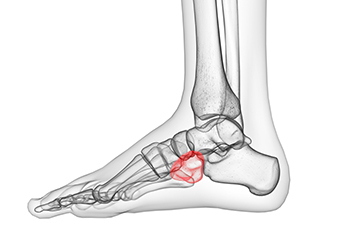Cuboid Syndrome Facts
Tuesday, 18 March 2025 00:00
Cuboid syndrome occurs when the cuboid bone in the foot becomes misaligned or partially dislocated, leading to pain and discomfort. The cuboid bone is located on the outer side of the foot, near the midfoot region, and plays a vital role in stability and movement. This condition often results from repetitive stress, overuse, or sudden trauma such as an ankle sprain. Poor foot biomechanics, tight calf muscles, or wearing inadequate footwear can also contribute to its development. Symptoms include pain along the outer edge of the foot, difficulty walking, and swelling in the affected area. Some individuals may experience weakness or instability while bearing weight. If you have pain in this part of your foot, it is suggested that you consult a podiatrist who can offer you appropriate treatment solutions.
Cuboid syndrome, also known as cuboid subluxation, occurs when the joints and ligaments near the cuboid bone in the foot become torn. If you have cuboid syndrome, consult with Gregory Rorick, DPM from Rorick Podiatry, PC. Our doctor will assess your condition and provide you with quality foot and ankle treatment.
Cuboid syndrome is a common cause of lateral foot pain, which is pain on the outside of the foot. The condition may happen suddenly due to an ankle sprain, or it may develop slowly overtime from repetitive tension through the bone and surrounding structures.
Causes
The most common causes of cuboid syndrome include:
- Injury – The most common cause of this ailment is an ankle sprain.
- Repetitive Strain – Tension placed through the peroneus longus muscle from repetitive activities such as jumping and running may cause excessive traction on the bone causing it to sublux.
- Altered Foot Biomechanics – Most people suffering from cuboid subluxation have flat feet.
Symptoms
A common symptom of cuboid syndrome is pain along the outside of the foot which can be felt in the ankle and toes. This pain may create walking difficulties and may cause those with the condition to walk with a limp.
Diagnosis
Diagnosis of cuboid syndrome is often difficult, and it is often misdiagnosed. X-rays, MRIs and CT scans often fail to properly show the cuboid subluxation. Although there isn’t a specific test used to diagnose cuboid syndrome, your podiatrist will usually check if pain is felt while pressing firmly on the cuboid bone of your foot.
Treatment
Just as the range of causes varies widely, so do treatments. Some more common treatments are ice therapy, rest, exercise, taping, and orthotics.
If you have any questions, please feel free to contact our office located in New York Mills, Utica, NY . We offer the newest diagnostic and treatment technologies for all your foot care needs.









